BCO2000 Business Process Modelling Assignment 1 - Solutions & Analysis
VerifiedAdded on 2022/09/09
|8
|1736
|13
Homework Assignment
AI Summary
This document presents a comprehensive solution to a Business Process Modelling assignment (BCO2000). It addresses key concepts such as the hierarchical organizational structure, its evolution, benefits, and drawbacks. The assignment explores functional and enterprise information systems, detailing their value and differences. It further delves into the functional versus process view of organizations and their significance in modern business, including the importance of three-way matching within procurement. The solution also clarifies the distinction between a Bill of Materials and Product Routing, addresses problems associated with manual business processes and how enterprise systems solve them. Finally, it explains the difference between Made to Order and Made to Stock production strategies, and includes the impact of globalization on organizations and the difference between master and transaction data in SAP environment.
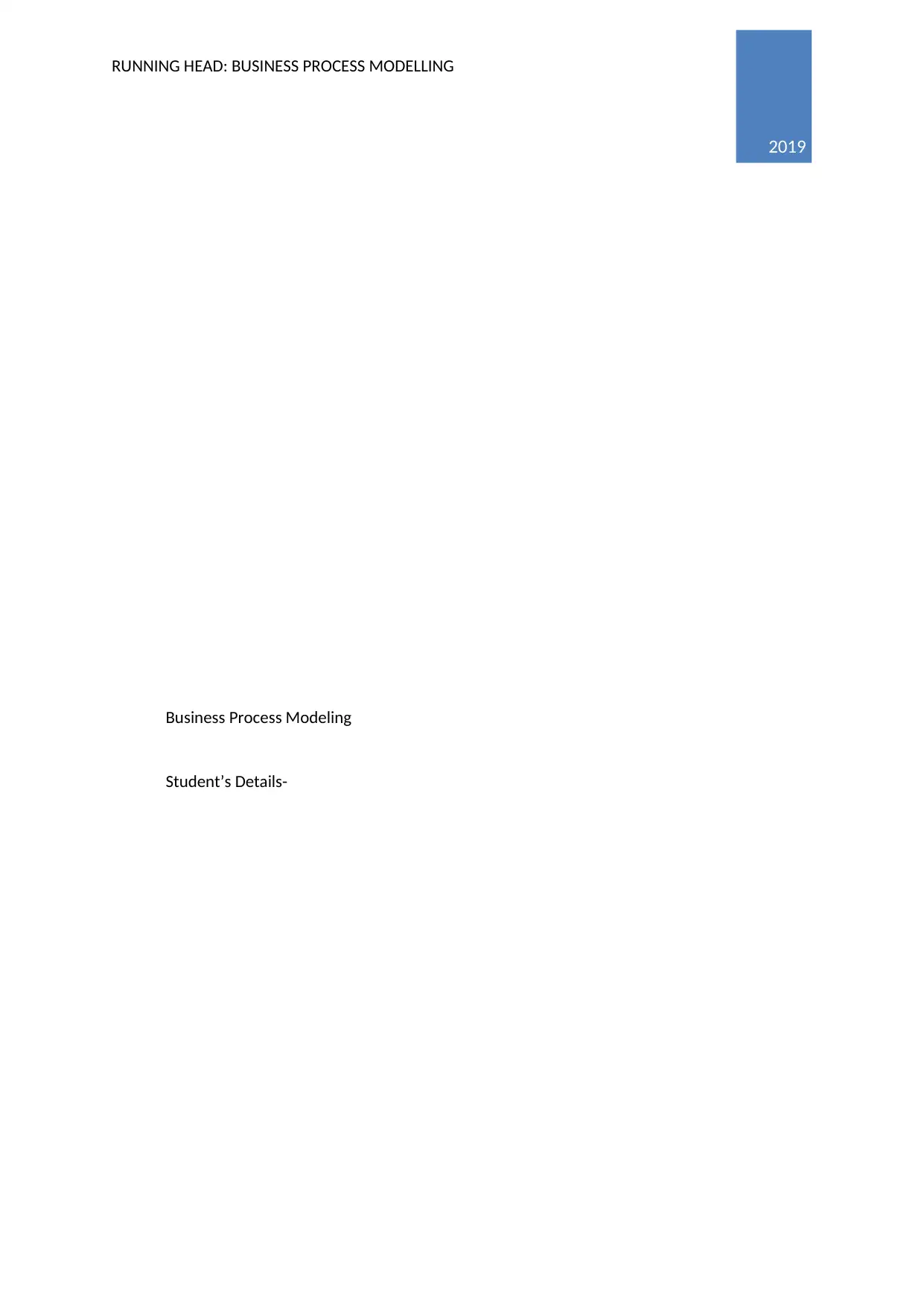
RUNNING HEAD: BUSINESS PROCESS MODELLING 0
2019
Business Process Modeling
Student’s Details-
2019
Business Process Modeling
Student’s Details-
Paraphrase This Document
Need a fresh take? Get an instant paraphrase of this document with our AI Paraphraser
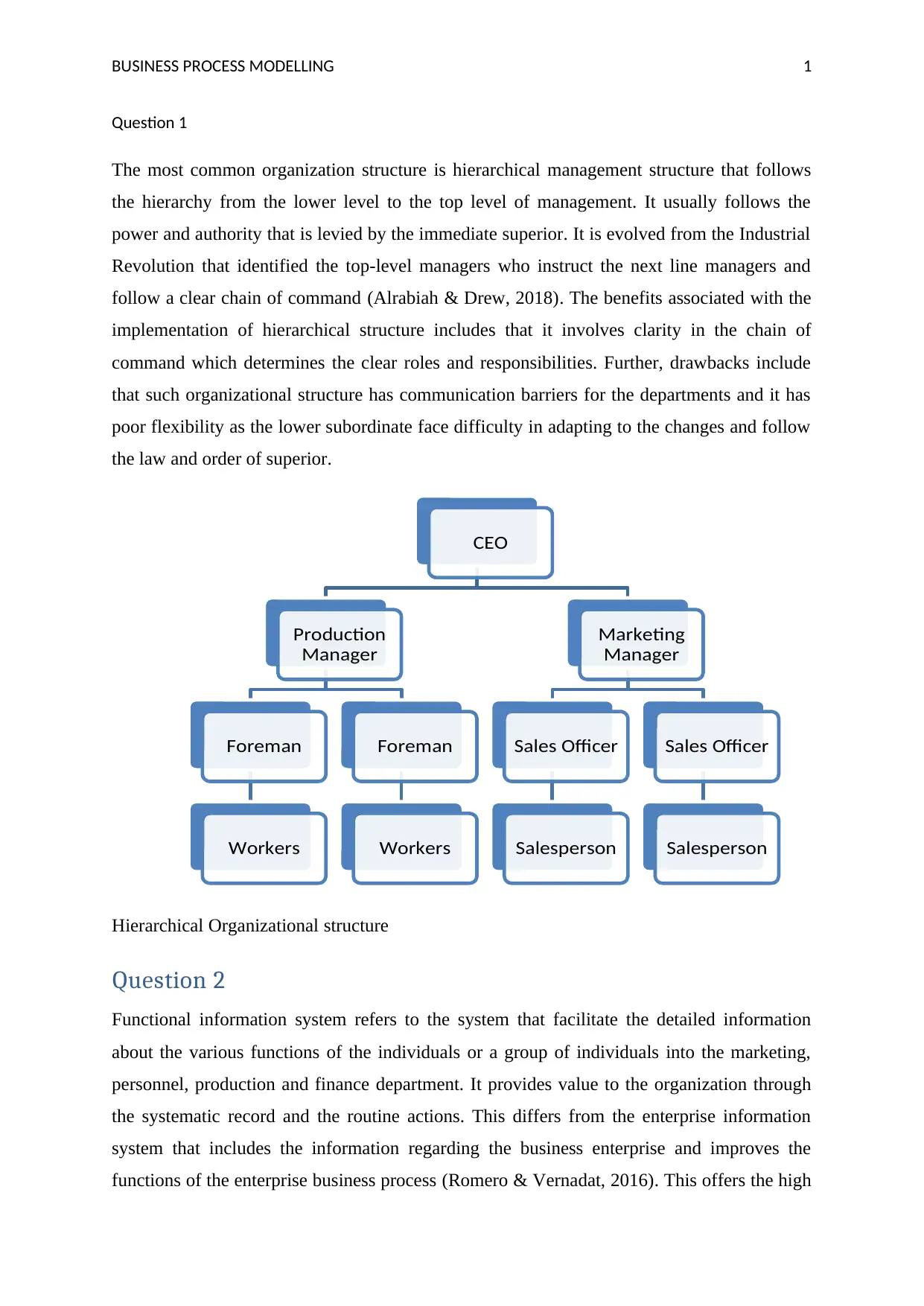
BUSINESS PROCESS MODELLING 1
Question 1
The most common organization structure is hierarchical management structure that follows
the hierarchy from the lower level to the top level of management. It usually follows the
power and authority that is levied by the immediate superior. It is evolved from the Industrial
Revolution that identified the top-level managers who instruct the next line managers and
follow a clear chain of command (Alrabiah & Drew, 2018). The benefits associated with the
implementation of hierarchical structure includes that it involves clarity in the chain of
command which determines the clear roles and responsibilities. Further, drawbacks include
that such organizational structure has communication barriers for the departments and it has
poor flexibility as the lower subordinate face difficulty in adapting to the changes and follow
the law and order of superior.
Hierarchical Organizational structure
Question 2
Functional information system refers to the system that facilitate the detailed information
about the various functions of the individuals or a group of individuals into the marketing,
personnel, production and finance department. It provides value to the organization through
the systematic record and the routine actions. This differs from the enterprise information
system that includes the information regarding the business enterprise and improves the
functions of the enterprise business process (Romero & Vernadat, 2016). This offers the high
CEO
Production
Manager
Foreman
Workers
Foreman
Workers
Marketing
Manager
Sales Officer
Salesperson
Sales Officer
Salesperson
Question 1
The most common organization structure is hierarchical management structure that follows
the hierarchy from the lower level to the top level of management. It usually follows the
power and authority that is levied by the immediate superior. It is evolved from the Industrial
Revolution that identified the top-level managers who instruct the next line managers and
follow a clear chain of command (Alrabiah & Drew, 2018). The benefits associated with the
implementation of hierarchical structure includes that it involves clarity in the chain of
command which determines the clear roles and responsibilities. Further, drawbacks include
that such organizational structure has communication barriers for the departments and it has
poor flexibility as the lower subordinate face difficulty in adapting to the changes and follow
the law and order of superior.
Hierarchical Organizational structure
Question 2
Functional information system refers to the system that facilitate the detailed information
about the various functions of the individuals or a group of individuals into the marketing,
personnel, production and finance department. It provides value to the organization through
the systematic record and the routine actions. This differs from the enterprise information
system that includes the information regarding the business enterprise and improves the
functions of the enterprise business process (Romero & Vernadat, 2016). This offers the high
CEO
Production
Manager
Foreman
Workers
Foreman
Workers
Marketing
Manager
Sales Officer
Salesperson
Sales Officer
Salesperson
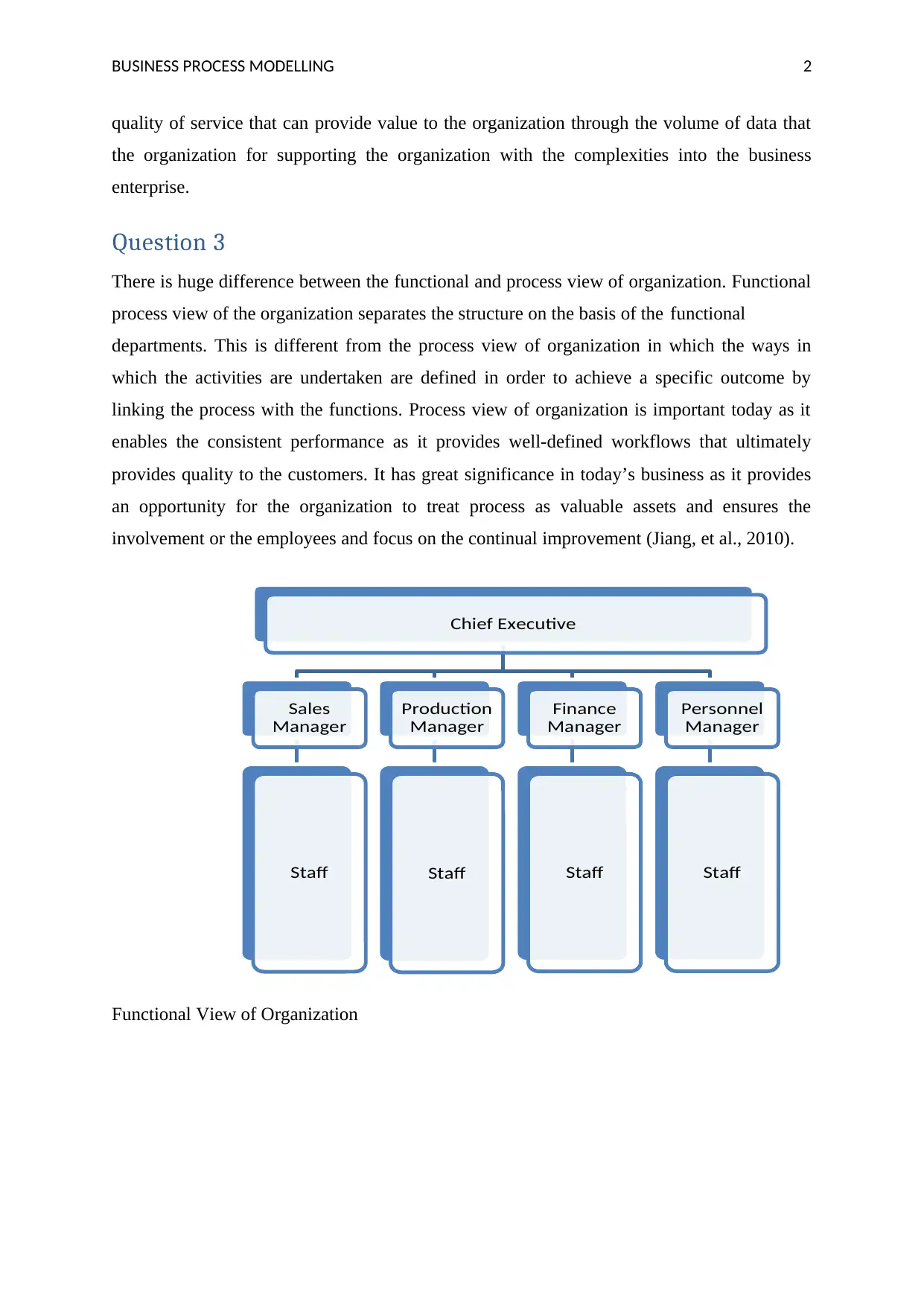
BUSINESS PROCESS MODELLING 2
quality of service that can provide value to the organization through the volume of data that
the organization for supporting the organization with the complexities into the business
enterprise.
Question 3
There is huge difference between the functional and process view of organization. Functional
process view of the organization separates the structure on the basis of the functional
departments. This is different from the process view of organization in which the ways in
which the activities are undertaken are defined in order to achieve a specific outcome by
linking the process with the functions. Process view of organization is important today as it
enables the consistent performance as it provides well-defined workflows that ultimately
provides quality to the customers. It has great significance in today’s business as it provides
an opportunity for the organization to treat process as valuable assets and ensures the
involvement or the employees and focus on the continual improvement (Jiang, et al., 2010).
Functional View of Organization
Chief Executive
Sales
Manager
Staff
Production
Manager
Staff
Finance
Manager
Staff
Personnel
Manager
Staff
quality of service that can provide value to the organization through the volume of data that
the organization for supporting the organization with the complexities into the business
enterprise.
Question 3
There is huge difference between the functional and process view of organization. Functional
process view of the organization separates the structure on the basis of the functional
departments. This is different from the process view of organization in which the ways in
which the activities are undertaken are defined in order to achieve a specific outcome by
linking the process with the functions. Process view of organization is important today as it
enables the consistent performance as it provides well-defined workflows that ultimately
provides quality to the customers. It has great significance in today’s business as it provides
an opportunity for the organization to treat process as valuable assets and ensures the
involvement or the employees and focus on the continual improvement (Jiang, et al., 2010).
Functional View of Organization
Chief Executive
Sales
Manager
Staff
Production
Manager
Staff
Finance
Manager
Staff
Personnel
Manager
Staff
⊘ This is a preview!⊘
Do you want full access?
Subscribe today to unlock all pages.

Trusted by 1+ million students worldwide
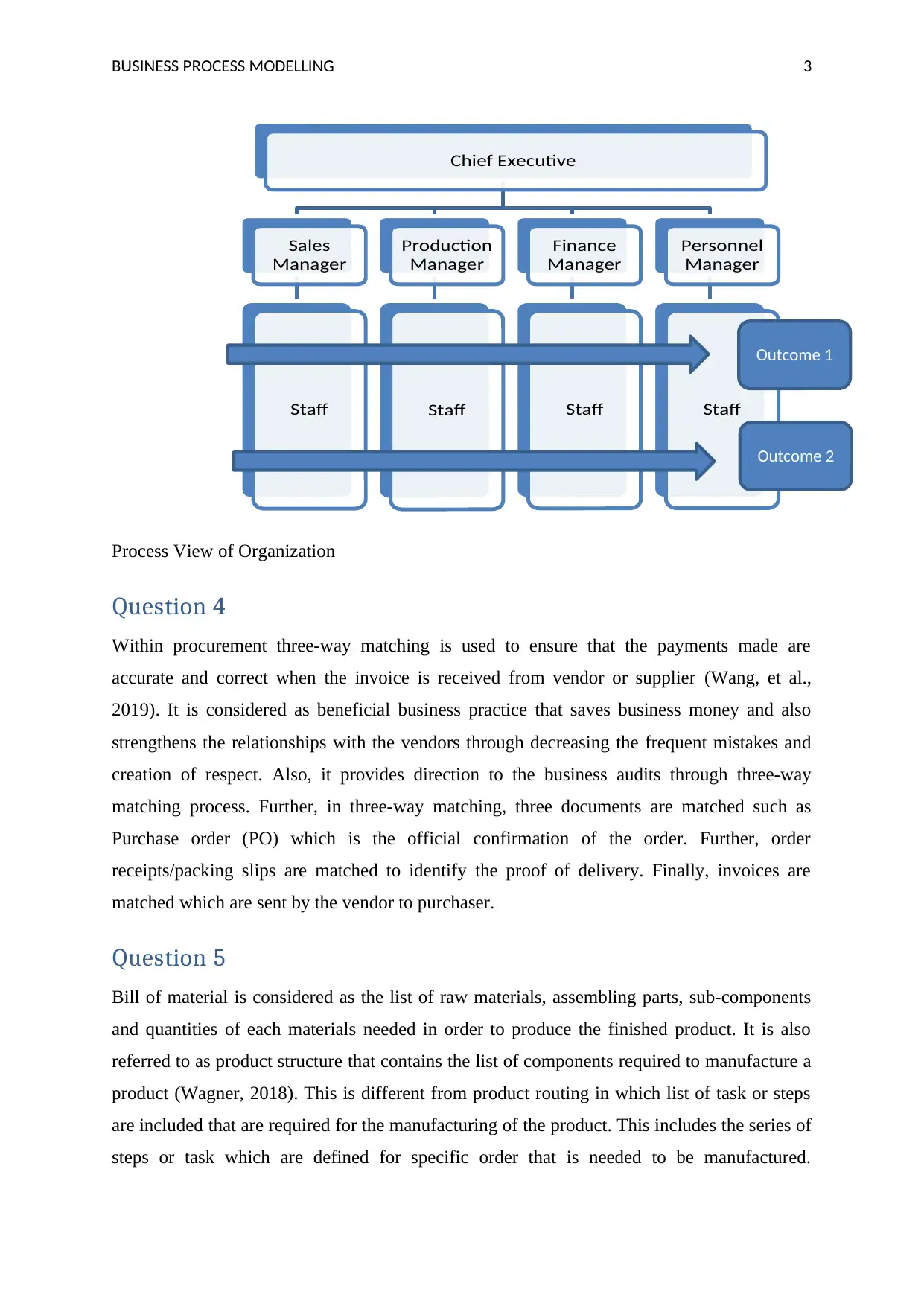
BUSINESS PROCESS MODELLING 3
Process View of Organization
Question 4
Within procurement three-way matching is used to ensure that the payments made are
accurate and correct when the invoice is received from vendor or supplier (Wang, et al.,
2019). It is considered as beneficial business practice that saves business money and also
strengthens the relationships with the vendors through decreasing the frequent mistakes and
creation of respect. Also, it provides direction to the business audits through three-way
matching process. Further, in three-way matching, three documents are matched such as
Purchase order (PO) which is the official confirmation of the order. Further, order
receipts/packing slips are matched to identify the proof of delivery. Finally, invoices are
matched which are sent by the vendor to purchaser.
Question 5
Bill of material is considered as the list of raw materials, assembling parts, sub-components
and quantities of each materials needed in order to produce the finished product. It is also
referred to as product structure that contains the list of components required to manufacture a
product (Wagner, 2018). This is different from product routing in which list of task or steps
are included that are required for the manufacturing of the product. This includes the series of
steps or task which are defined for specific order that is needed to be manufactured.
Chief Executive
Sales
Manager
Staff
Production
Manager
Staff
Finance
Manager
Staff
Personnel
Manager
Staff
Outcome 1
Outcome 2
Process View of Organization
Question 4
Within procurement three-way matching is used to ensure that the payments made are
accurate and correct when the invoice is received from vendor or supplier (Wang, et al.,
2019). It is considered as beneficial business practice that saves business money and also
strengthens the relationships with the vendors through decreasing the frequent mistakes and
creation of respect. Also, it provides direction to the business audits through three-way
matching process. Further, in three-way matching, three documents are matched such as
Purchase order (PO) which is the official confirmation of the order. Further, order
receipts/packing slips are matched to identify the proof of delivery. Finally, invoices are
matched which are sent by the vendor to purchaser.
Question 5
Bill of material is considered as the list of raw materials, assembling parts, sub-components
and quantities of each materials needed in order to produce the finished product. It is also
referred to as product structure that contains the list of components required to manufacture a
product (Wagner, 2018). This is different from product routing in which list of task or steps
are included that are required for the manufacturing of the product. This includes the series of
steps or task which are defined for specific order that is needed to be manufactured.
Chief Executive
Sales
Manager
Staff
Production
Manager
Staff
Finance
Manager
Staff
Personnel
Manager
Staff
Outcome 1
Outcome 2
Paraphrase This Document
Need a fresh take? Get an instant paraphrase of this document with our AI Paraphraser
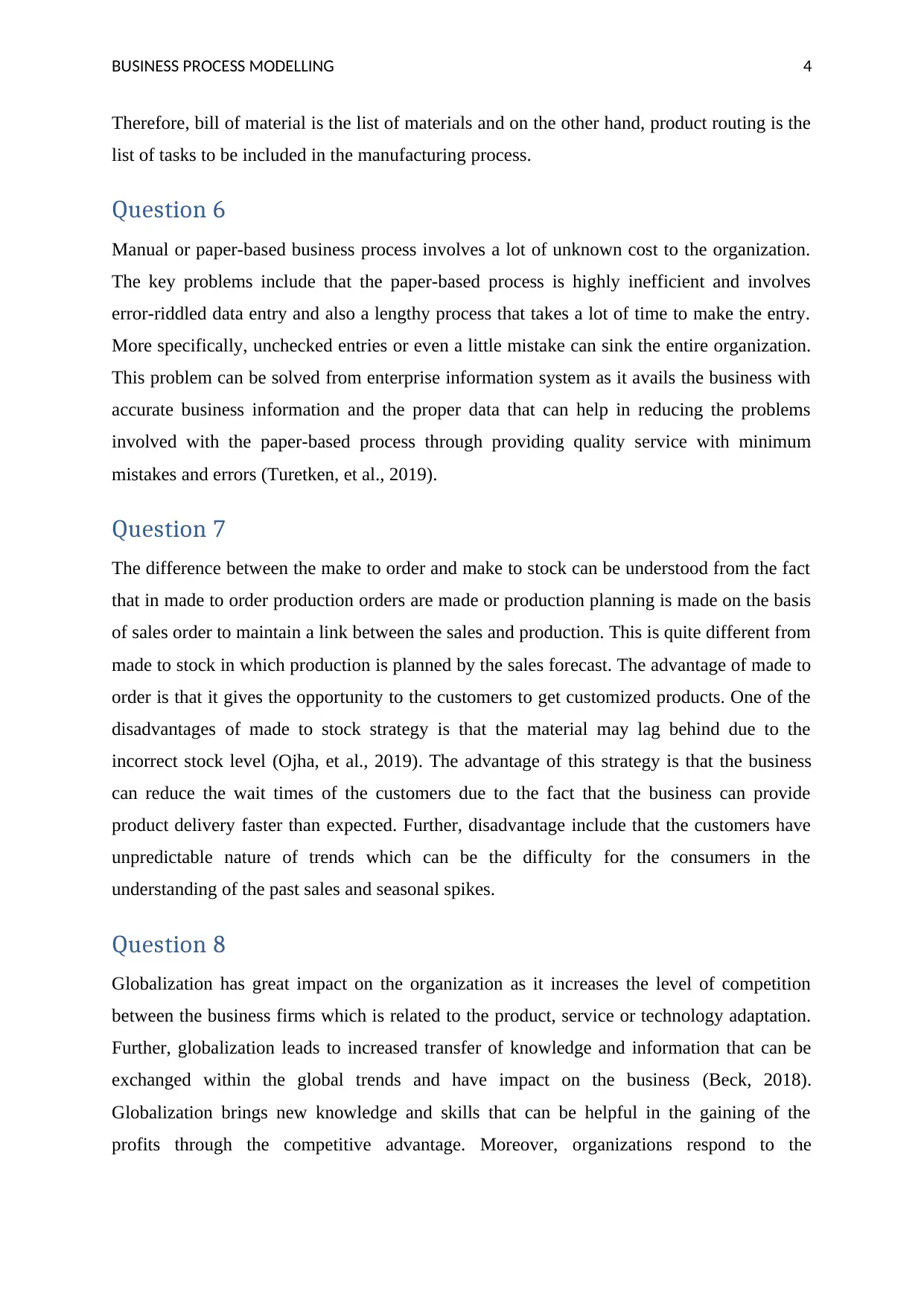
BUSINESS PROCESS MODELLING 4
Therefore, bill of material is the list of materials and on the other hand, product routing is the
list of tasks to be included in the manufacturing process.
Question 6
Manual or paper-based business process involves a lot of unknown cost to the organization.
The key problems include that the paper-based process is highly inefficient and involves
error-riddled data entry and also a lengthy process that takes a lot of time to make the entry.
More specifically, unchecked entries or even a little mistake can sink the entire organization.
This problem can be solved from enterprise information system as it avails the business with
accurate business information and the proper data that can help in reducing the problems
involved with the paper-based process through providing quality service with minimum
mistakes and errors (Turetken, et al., 2019).
Question 7
The difference between the make to order and make to stock can be understood from the fact
that in made to order production orders are made or production planning is made on the basis
of sales order to maintain a link between the sales and production. This is quite different from
made to stock in which production is planned by the sales forecast. The advantage of made to
order is that it gives the opportunity to the customers to get customized products. One of the
disadvantages of made to stock strategy is that the material may lag behind due to the
incorrect stock level (Ojha, et al., 2019). The advantage of this strategy is that the business
can reduce the wait times of the customers due to the fact that the business can provide
product delivery faster than expected. Further, disadvantage include that the customers have
unpredictable nature of trends which can be the difficulty for the consumers in the
understanding of the past sales and seasonal spikes.
Question 8
Globalization has great impact on the organization as it increases the level of competition
between the business firms which is related to the product, service or technology adaptation.
Further, globalization leads to increased transfer of knowledge and information that can be
exchanged within the global trends and have impact on the business (Beck, 2018).
Globalization brings new knowledge and skills that can be helpful in the gaining of the
profits through the competitive advantage. Moreover, organizations respond to the
Therefore, bill of material is the list of materials and on the other hand, product routing is the
list of tasks to be included in the manufacturing process.
Question 6
Manual or paper-based business process involves a lot of unknown cost to the organization.
The key problems include that the paper-based process is highly inefficient and involves
error-riddled data entry and also a lengthy process that takes a lot of time to make the entry.
More specifically, unchecked entries or even a little mistake can sink the entire organization.
This problem can be solved from enterprise information system as it avails the business with
accurate business information and the proper data that can help in reducing the problems
involved with the paper-based process through providing quality service with minimum
mistakes and errors (Turetken, et al., 2019).
Question 7
The difference between the make to order and make to stock can be understood from the fact
that in made to order production orders are made or production planning is made on the basis
of sales order to maintain a link between the sales and production. This is quite different from
made to stock in which production is planned by the sales forecast. The advantage of made to
order is that it gives the opportunity to the customers to get customized products. One of the
disadvantages of made to stock strategy is that the material may lag behind due to the
incorrect stock level (Ojha, et al., 2019). The advantage of this strategy is that the business
can reduce the wait times of the customers due to the fact that the business can provide
product delivery faster than expected. Further, disadvantage include that the customers have
unpredictable nature of trends which can be the difficulty for the consumers in the
understanding of the past sales and seasonal spikes.
Question 8
Globalization has great impact on the organization as it increases the level of competition
between the business firms which is related to the product, service or technology adaptation.
Further, globalization leads to increased transfer of knowledge and information that can be
exchanged within the global trends and have impact on the business (Beck, 2018).
Globalization brings new knowledge and skills that can be helpful in the gaining of the
profits through the competitive advantage. Moreover, organizations respond to the
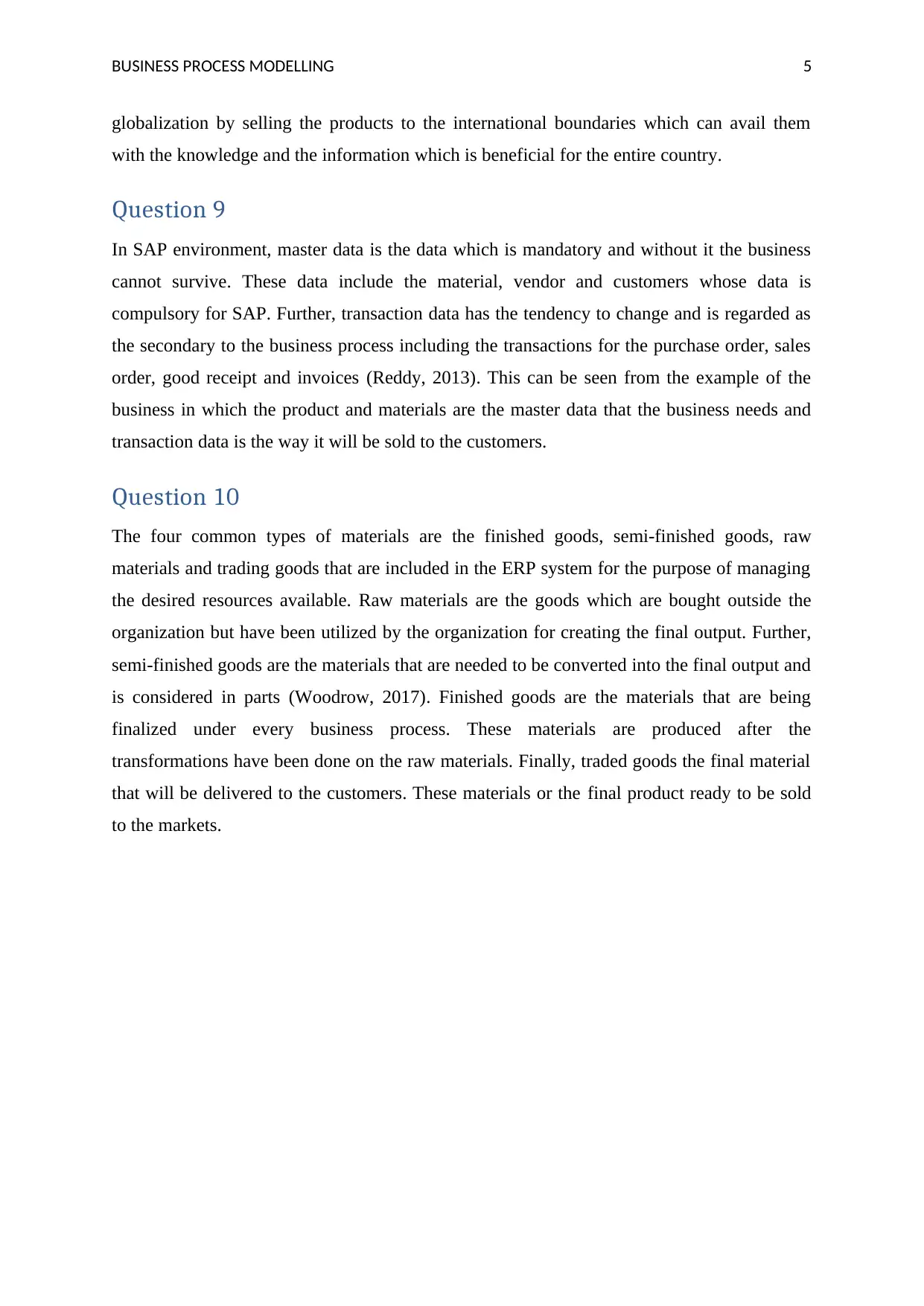
BUSINESS PROCESS MODELLING 5
globalization by selling the products to the international boundaries which can avail them
with the knowledge and the information which is beneficial for the entire country.
Question 9
In SAP environment, master data is the data which is mandatory and without it the business
cannot survive. These data include the material, vendor and customers whose data is
compulsory for SAP. Further, transaction data has the tendency to change and is regarded as
the secondary to the business process including the transactions for the purchase order, sales
order, good receipt and invoices (Reddy, 2013). This can be seen from the example of the
business in which the product and materials are the master data that the business needs and
transaction data is the way it will be sold to the customers.
Question 10
The four common types of materials are the finished goods, semi-finished goods, raw
materials and trading goods that are included in the ERP system for the purpose of managing
the desired resources available. Raw materials are the goods which are bought outside the
organization but have been utilized by the organization for creating the final output. Further,
semi-finished goods are the materials that are needed to be converted into the final output and
is considered in parts (Woodrow, 2017). Finished goods are the materials that are being
finalized under every business process. These materials are produced after the
transformations have been done on the raw materials. Finally, traded goods the final material
that will be delivered to the customers. These materials or the final product ready to be sold
to the markets.
globalization by selling the products to the international boundaries which can avail them
with the knowledge and the information which is beneficial for the entire country.
Question 9
In SAP environment, master data is the data which is mandatory and without it the business
cannot survive. These data include the material, vendor and customers whose data is
compulsory for SAP. Further, transaction data has the tendency to change and is regarded as
the secondary to the business process including the transactions for the purchase order, sales
order, good receipt and invoices (Reddy, 2013). This can be seen from the example of the
business in which the product and materials are the master data that the business needs and
transaction data is the way it will be sold to the customers.
Question 10
The four common types of materials are the finished goods, semi-finished goods, raw
materials and trading goods that are included in the ERP system for the purpose of managing
the desired resources available. Raw materials are the goods which are bought outside the
organization but have been utilized by the organization for creating the final output. Further,
semi-finished goods are the materials that are needed to be converted into the final output and
is considered in parts (Woodrow, 2017). Finished goods are the materials that are being
finalized under every business process. These materials are produced after the
transformations have been done on the raw materials. Finally, traded goods the final material
that will be delivered to the customers. These materials or the final product ready to be sold
to the markets.
⊘ This is a preview!⊘
Do you want full access?
Subscribe today to unlock all pages.

Trusted by 1+ million students worldwide
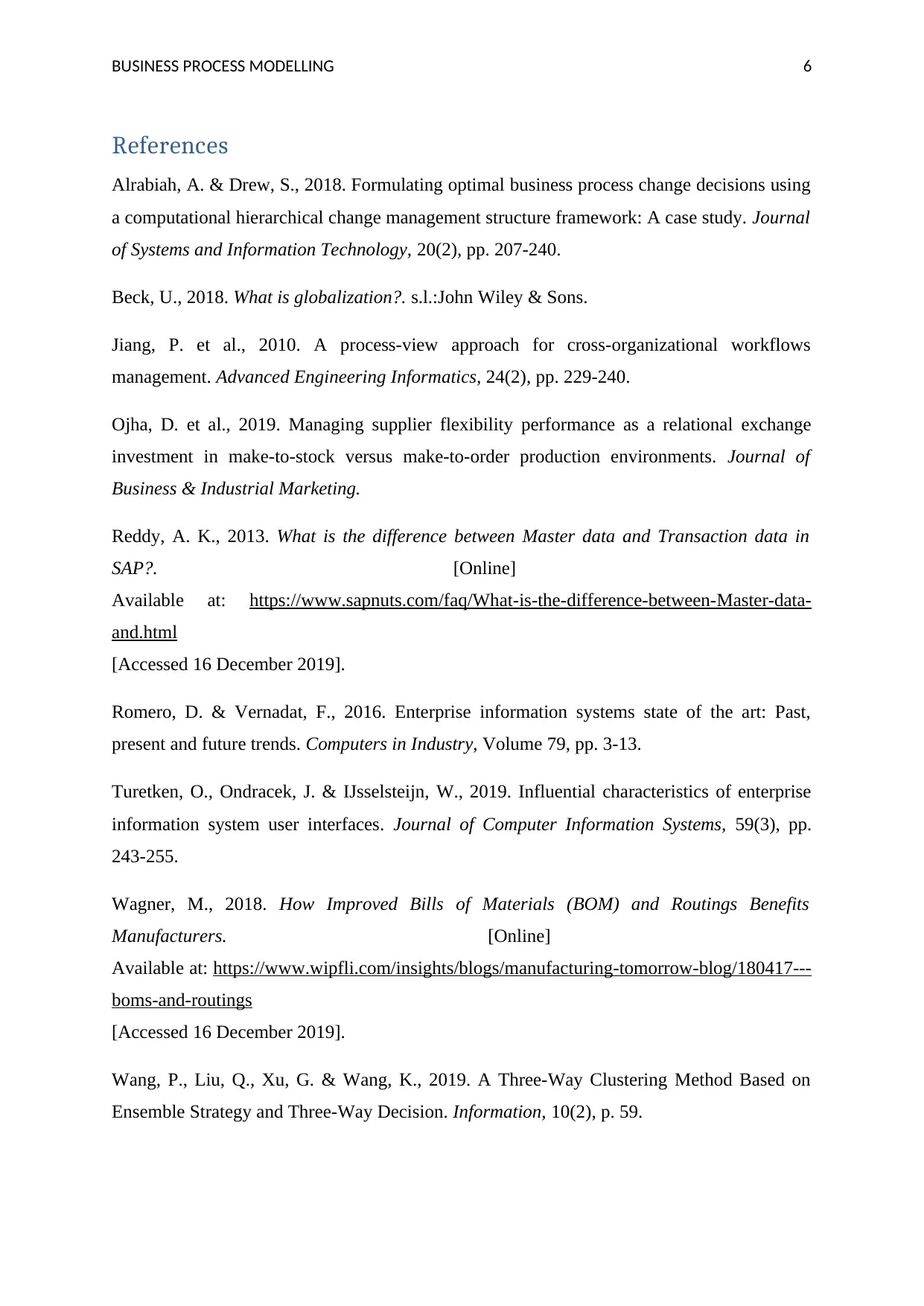
BUSINESS PROCESS MODELLING 6
References
Alrabiah, A. & Drew, S., 2018. Formulating optimal business process change decisions using
a computational hierarchical change management structure framework: A case study. Journal
of Systems and Information Technology, 20(2), pp. 207-240.
Beck, U., 2018. What is globalization?. s.l.:John Wiley & Sons.
Jiang, P. et al., 2010. A process-view approach for cross-organizational workflows
management. Advanced Engineering Informatics, 24(2), pp. 229-240.
Ojha, D. et al., 2019. Managing supplier flexibility performance as a relational exchange
investment in make-to-stock versus make-to-order production environments. Journal of
Business & Industrial Marketing.
Reddy, A. K., 2013. What is the difference between Master data and Transaction data in
SAP?. [Online]
Available at: https://www.sapnuts.com/faq/What-is-the-difference-between-Master-data-
and.html
[Accessed 16 December 2019].
Romero, D. & Vernadat, F., 2016. Enterprise information systems state of the art: Past,
present and future trends. Computers in Industry, Volume 79, pp. 3-13.
Turetken, O., Ondracek, J. & IJsselsteijn, W., 2019. Influential characteristics of enterprise
information system user interfaces. Journal of Computer Information Systems, 59(3), pp.
243-255.
Wagner, M., 2018. How Improved Bills of Materials (BOM) and Routings Benefits
Manufacturers. [Online]
Available at: https://www.wipfli.com/insights/blogs/manufacturing-tomorrow-blog/180417---
boms-and-routings
[Accessed 16 December 2019].
Wang, P., Liu, Q., Xu, G. & Wang, K., 2019. A Three-Way Clustering Method Based on
Ensemble Strategy and Three-Way Decision. Information, 10(2), p. 59.
References
Alrabiah, A. & Drew, S., 2018. Formulating optimal business process change decisions using
a computational hierarchical change management structure framework: A case study. Journal
of Systems and Information Technology, 20(2), pp. 207-240.
Beck, U., 2018. What is globalization?. s.l.:John Wiley & Sons.
Jiang, P. et al., 2010. A process-view approach for cross-organizational workflows
management. Advanced Engineering Informatics, 24(2), pp. 229-240.
Ojha, D. et al., 2019. Managing supplier flexibility performance as a relational exchange
investment in make-to-stock versus make-to-order production environments. Journal of
Business & Industrial Marketing.
Reddy, A. K., 2013. What is the difference between Master data and Transaction data in
SAP?. [Online]
Available at: https://www.sapnuts.com/faq/What-is-the-difference-between-Master-data-
and.html
[Accessed 16 December 2019].
Romero, D. & Vernadat, F., 2016. Enterprise information systems state of the art: Past,
present and future trends. Computers in Industry, Volume 79, pp. 3-13.
Turetken, O., Ondracek, J. & IJsselsteijn, W., 2019. Influential characteristics of enterprise
information system user interfaces. Journal of Computer Information Systems, 59(3), pp.
243-255.
Wagner, M., 2018. How Improved Bills of Materials (BOM) and Routings Benefits
Manufacturers. [Online]
Available at: https://www.wipfli.com/insights/blogs/manufacturing-tomorrow-blog/180417---
boms-and-routings
[Accessed 16 December 2019].
Wang, P., Liu, Q., Xu, G. & Wang, K., 2019. A Three-Way Clustering Method Based on
Ensemble Strategy and Three-Way Decision. Information, 10(2), p. 59.
Paraphrase This Document
Need a fresh take? Get an instant paraphrase of this document with our AI Paraphraser
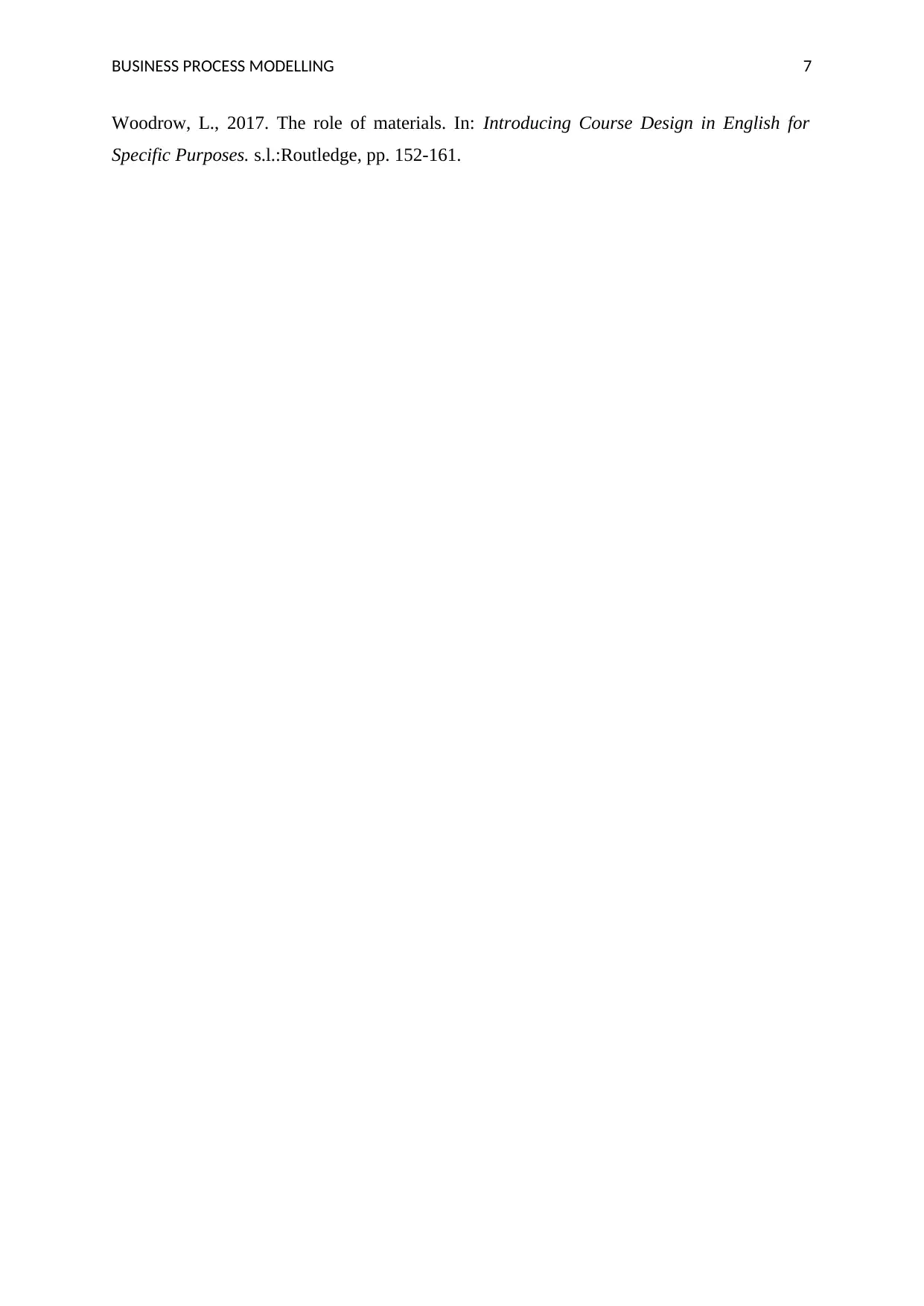
BUSINESS PROCESS MODELLING 7
Woodrow, L., 2017. The role of materials. In: Introducing Course Design in English for
Specific Purposes. s.l.:Routledge, pp. 152-161.
Woodrow, L., 2017. The role of materials. In: Introducing Course Design in English for
Specific Purposes. s.l.:Routledge, pp. 152-161.
1 out of 8
Related Documents
Your All-in-One AI-Powered Toolkit for Academic Success.
+13062052269
info@desklib.com
Available 24*7 on WhatsApp / Email
![[object Object]](/_next/static/media/star-bottom.7253800d.svg)
Unlock your academic potential
Copyright © 2020–2025 A2Z Services. All Rights Reserved. Developed and managed by ZUCOL.




